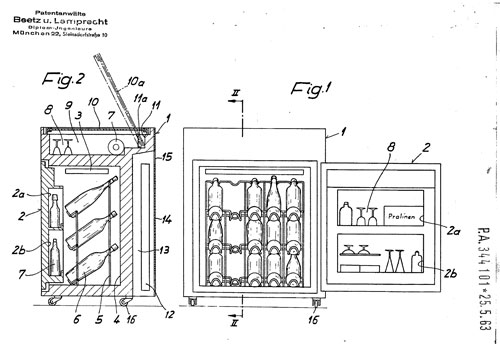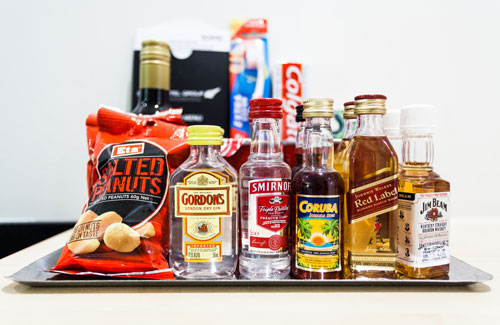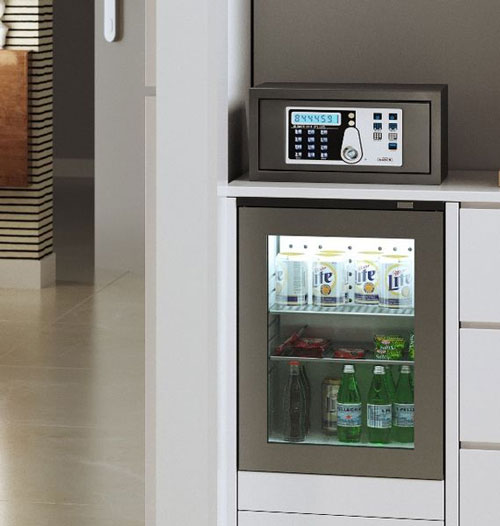Tales From The Minibar
The hotel minibar was an exciting and interesting new direction for hotels at first. But it’s since declined. Is a lack of new minibar ideas to blame?
1876
The year that the compact refrigerator was invented by Carl von Linde, a German man whose goal was to come up with a process of liquefying gases en masse. Von Linde’s work, which originally found success with German breweries, expanded far beyond the refrigerator, however. His still-active company, The Linde Group, is the world’s largest industrial gas company with around $21 billion in revenue in 2017 alone.

A drawing included with the German patent for the original refrigerated minibar.
The technologies that made the minibar possible
The genesis of the modern refrigerated minibar is commonly attributed to a Hong Kong Hilton location that, in the mid-1970s, saw much success by adding liquor to its many fridges—and likely kicked off the trend at luxury hotels worldwide after it saw drink purchases surge by a not-insubstantial 500 percent. Per the South China Morning Post, the minibar gained tiny bottles of liquor thanks to Robert Arnold, the food and beverage director of the hotel chain at the time. Arnold was inspired by a mini-bottle of liquor he got on a flight over the South China Sea and wondered if it would be a good fit for the mini-fridges the hotel chain had just acquired. As it turns out, they were.
While the Hong Kong location was certainly early, the minibar is actually quote a few years older than that. For one thing, a 1971 Associated Press story featuring the then-head of New Jersey’s Alcohol Beverage Control bureau noted that the state was eyeing putting tiny liquor bottles in those fridges—a full three years before the Hong Kong Hilton offered up its version of the idea.
Going even further back, evidence of its creation exists more than a decade prior to the creation of the Hong Kong Hilton, and can be traced back to a 1963 patent from Siegas Metallwarenfabrik, a German manufacturing firm that specialized in industrial products, including refrigeration technologies.
The 1963 patent is in German and I’m therefore relying on Google Translate to make it clear, but the basic gist of the patent was that the refrigerator was designed to cool glass bottles at a consistent temperature all the way through, while allowing hotel guests to grab out a bottle at will without disturbing other bottles in the fridge.
While examples of refrigerators or food storage mechanisms designed for hotel rooms had surfaced prior to 1963, it appears Siegas was first to build a fridge around beverages, including alcohol and soft drinks.
And after it was conceived, the innovation did not appear in Hong Kong first, but in the hotels of Washington, D.C., with one of the District’s most iconic venues, the Madison Hotel, getting the minibars upon its opening—at the behest of John F. Kennedy, no less—in February of 1963.
The minibars, a common element of D.C. luxury hotels of the era, had their way of showing up at modestly historic times. A post-Pentagon Papers New York Times profile of leaker Daniel Ellsberg briefly touches on the “soft drinks and cheese” Ellsberg and his interviewer grabbed from a lounge minibar.
And the Madison Hotel’s minibars even played a small role in the ending of the Cold War. Historian Martin McCauley’s book The Cold War 1949-2016 noted that, during the 1987 Washington Summit, in which Mikhail Gorbachev met with Ronald Reagan at the White House amid a thaw in U.S.-Soviet, the minibars at the Madison were heavily used—perhaps too heavily.
“The Soviet delegation stayed at the Madison Hotel where the minibar was replete with wines and spirits,” McCauley wrote. “They imbibed so heavily that the head of mission had to ask the hotel to replace alcohol with soft drinks! Outside, they gorged on Big Macs and Cola.”
Colin Powell also recalled the incident in his 1995 book My American Journey, noting that the Soviets racked up a $1,400 bill on minibar alcohol in a single night.
This was the image that top Russians had of our country—that you could get spirits inside a tiny fridge in a snazzy hotel room.
“It always surprises people that, as much as we charge at the minibar, we actually don’t MAKE money in the minibar.”
— Arne M. Sorenson, the CEO of Marriott, in a comment tweeted by CNBC reporter Carl Quintanilla in 2014. The comment was quickly deleted by Quintanilla, but Fast Company kept it around for posterity. Sorenson’s sentiment isn’t actually uncommon in the sector. Despite the fact that minibars are infamous for charging $9 for a bottle of beer and $8 for a can of soda, they represent a downright tiny share of the hotel industry’s revenue—a 2017 report from CRBE Hotels found that minibars represented just 0.4 percent of total food and beverage service revenue. The reason it's so unprofitable? Simple: There's a lot of overhead due to all the workers needed to restock the fridges.

Odds are that you may not find a minibar with an actual fridge on your next trip. (russellstreet/Flickr)
Five ways hotels are modernizing the minibar experience
- Pulling snacks out of the fridge: Per The Wall Street Journal, the move to keep candy bars and other snacks at room temperature has everything to do with satiating your hunger. “It may be harder to resist that chocolate bar if it's staring at you from the TV stand,” Journal reporter Andrea Petersen explained.
- Adding technology:Hotel News Now reports that some hotel chains have added digital tablets to their minibar displays in an attempt to revamp the experience. This also extends to the products sold in minibars—with USB drives and charging cables made easily accessible in room.
- The use of automation: In recent years, hotels have started to use fridges that can automatically detect when an object has been moved from a minibar. The reason for this is less because they’re trying to screw the customers and more because of inventory control. A major reason that minibars are so hard to make money from is because they’re difficult to restock. Automated minibars get rid of this problem, and help make minibars more profitable, by making it easy to track inventory automatically. Of course, this is no fun for hotel guests that get charged for moving a Snickers bar.
- Getting rid of the fridges entirely: Bartech, perhaps the most prominent company in the minibar vendor space, has been selling a concept called the wireless eTray in recent years, which is designed to be placed anywhere in a room and only sells goods intended to be consumed at room temperature, like bottled water, cookies, or wine.
- Dedicated appliances and robots: Perhaps the future of the minibar won’t look like a minibar at all. A 2015 piece by the Las Vegas Review-Journal suggested that robot bartenders could one day usurp minibars, and we’re already starting to see some of that in some hotels. The Plum wine dispenser allows hotels to “pour” one of two bottles of wine for guests. The technology was built for hotels, but they sell it at Williams-Sonoma if you want to spend a lot of money on being lazy.
“I've stayed in a bunch of hotels from a small boutique hotel on Easter Island, to a luxury suite overlooking the Bangkok skyline, to a two-bedroom villa on Koh Samui, and never come across this kind of fee.”
— Keri Anderson, a travel blogger known for her site Heels First Travel, discussing with the Daily Mail how a Las Vegas hotel tried to charge her money for putting her own stuff in the hotel minibar. Anderson is a seasoned traveler, but even that threw her for a loop.

A minibar fridge. (Wikimedia Commons)
Does the minibar have a future?
It’s not hard to run into a story about how the minibar is in decline or will soon be on the way out.
The New York Times dedicated an article to it last year, and they were probably late to the trend. The Huffington Post write about it way back in 2014, noting that some chains were dropping the feature or paring it down, in part because of a 28 percent drop in sales between 2007 and 2012.
In some ways, it makes sense why some think minibars are on their way out. There’s only so much stuff you can fit in a tiny fridge, or perhaps a kiosk on the wall. It makes more sense, logically, to have a built-in convenience store, which gives hotel customers a broader array of options than you might expect to find in a dedicated room fridge.
But on the other hand, it represents a missed opportunity for hotels to win consumers over with the psychological mechanics that come with your average hotel stay.
Perhaps the problem has less to do with the minibar concept itself and more with what you can get out of that minibar. While chatter around the decline of refrigerated minibars has increased in the past few years, some boutique hotels have responded to minibar criticism by improving the quality of the goods sold within the minibar.
In other words, the reason why minibars suck is because of Diet Coke and Jack Daniel’s being a mainstay in every one, not because minibars are a terrible idea in general.
In a piece for GQ last year, writer Mark Byrne made the case that minibars were secretly in a renaissance, by doing things like pre-bottling cocktails, embracing their local liquor scenes, and improving the quality of the mixing equipment. Having a shaker in the room is a nice perk.
Another example of this surfaced just this week: The Los Angeles Times, which covered the minibar’s decline back in 2013, wrote this week about the decision by the hotel chain Standard International to offer in its minibars a lotion and a gumdrop snack laced with cannabidiol, a key compound of marijuana that generally isn’t as psychoactive as actual marijuana. (Standard, interestingly, is teaming with Lord Jones, a cannabis company that plans to open a dispensary at one of the chain’s locations.)
That’s a left-field turn, sure, but the hotel industry could use a little left field right now.
Of course, this isn’t really happening in the national chains so much as the boutique hotels. But those boutiques are the ones that often set the stage for innovations that show up at larger chains—because they’re the pacesetters, the idea labs, the petri dishes of the hotel industry.
Sure, it gets watered down by the time it gets to the Sioux City Hilton, but the idea could have legs in the right context.
The thing that’s fascinating about the hotel minibar is how perception has shifted of the offering over the years.
That 1971 Associated Press story about New Jersey’s research into adding minibars to hotels around the state—three years before the Hong Kong Hilton had the same idea—was centered around an argument for “convenience and comfort for the public,” while the state’s Alcohol Beverage Control bureau noted that when you broke it down, a mini-fridge didn’t actually hold all that much alcohol.
Meanwhile, the Los Angeles Times noted in a 1985 article that the mini-bar “unburdens room service” from small, annoying requests.
These days, the minibar isn’t seen as a perk for the public, but an expensive cash grab. And many hoteliers see minibars as something more actively burdening than unburdening.
Is the problem with the minibar that we simply find the idea of pre-packaged food and drinks already living in your hotel room kind of boring? Admittedly, other parts of the hotel experience suffer from this as well. For example, room service can often be a repetitive affair when you’re stuck ordering the burger and fries because it’s the only thing on the menu that seems like an actual meal and doesn’t cost $35.
Sure, technology can fix or minimize some of these problems, but what if the real problem is a lack of new ideas?
:format(jpeg)/2018/04/tedium040318.gif)
/2018/04/tedium040318.gif)

/uploads/ernie_crop.jpg)